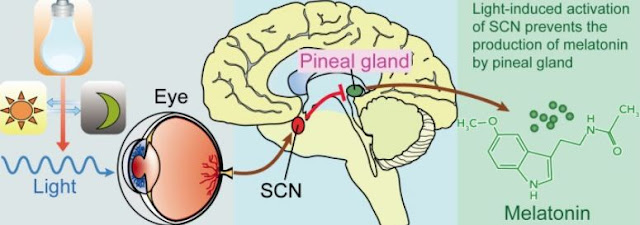INTRODUCTION
The Pineal gland also referred as pineal body or epiphysis cerebri. This gland has specialized secretory cells called pinealocytes. Pinealocytes secretes the hormone ‘Melatonin’. This hormone regulates our sleep at night and waking up in the morning by affecting different cells within the brain and body.
This gland situated in the centre of the brain, i.e., in between the left and right hemispheres. The size of this gland is same as like the grain of rice.
Image Source : Wikimedia CommonsLOCATION OF PINEAL GLAND
HORMONE AND FUCTIONS OF PINEAL GLAND
- It manages the circadian (or biological) rhythm
- Regulate certain reproductive hormones.
CIRCADIAN (OR BIOLOGICAL) RHYTHM
Circadian rhythm is a 24-hour biological cycle categorized by sleep-wake order. Melatonin regulates our daily sleep cycle.
The productivity of melatonin based on how human eyes affected by light. The existence of light stops the secretion of melatonin whereas in the non-existence of light (during night) produces more melatonin. This helps in sleep.
The body undergoes many changes like dropping of internal temperature, changes in the breathing rate.
THE SUPRACHIASMATIC NUCLEI (SCN)
 |
Light, suprachiasmatic nuclei (SCN), and the pinealmelatonin circuit |
Image Source : Wikimedia Commons
The Suprachiasmatic nucleus (SCN) is the circadian clock found in mammals that aids in modulating the Circadian rhythms. The SCN situated in the anterior part of the hypothalamus, which composed of nearly 20000 neurons.
The SCN partitioned into two segments based on the neuropeptide expression (Core and the Shell)
- The Core composed of vasoactive intestinal peptide (VIP) cells. The core chiefly obtains the input from the retina of the eyes and other brain parts.
- The Shell composed of arginine vasopressin (AVP) cells. The Shell obtains the input mostly from the Cortex, basal forebrain and, hypothalamus.
The SCN transmits the result to several parts of the brain like the hypothalamus and thalamus.
The SCN handles two types of data; photic and non-photic.
- The photic data arrive from the inherent photosensitive retinal ganglion cells (ipRGCs). These ipRGCs protrude from the retino-thalamic tract via glutamatergic synapses to neurons in the SCN, which assist to coordinate the circadian clock.
Exhibiting to light changes the circadian rhythm referred to as ‘Phase Shift’. Exhibiting to light during night affects sleep patterns.
- The non-photic data to the SCN arrive from other parts of the brain and assists in adjusting the circadian rhythm.
The SCN comprised of many serotonin (5-HT) receptors. 5-HT receives data from the midbrain and helps to regulate SCN by controlling phase shifts.
Cortisol discharges from the adrenal gland and exposes the circadian rhythm. The levels of Cortisol are mild during the night and extreme during the morning. The hypothalamic-pituitary-adrenal axis (HPA) modulates the release of Cortisol hormone.
REPRODUCTION
There are several receptors of melatonin present in various parts of the human body. It is present in ovaries too, which affects the menstrual cycle (time of onset, period, frequency) based on the levels of secretion.
Melatonin inhibits the secretion of gonadotropins (luteinizing hormone and follicle stimulating hormone) from the anterior pituitary gland. This hormone helps in the growth and functions of ovaries and testes.
DISORDERS
Naturally, melatonin is an anti-aging substance that decreases when people becomes older. The loss of melatonin results in age-related illnesses. This is because of chronic stress, poor diet, depression and sexual dysfunction reduces the level of melatonin. This in turn affects the sleep cycles and the mood of the person.
A pineal tumour, dangerous complication found in 1% of all brain tumours. There are at least 17 types of tumors arise in this gland. The most common tumors are ‘gliomas’, ‘pineal cell tumours’, ‘germ cell tumours’. The symptoms are headaches, seizures, nausea, visual changes, and problems with recalling of memories.
The treatments for pineal tumors are Radiation therapy and surgery.
The other general disorder is the occurrence of Pineal cysts or cysts of the pineal gland. This case found in 10% of people who undergoes Ct or MRI scans, since this cysts does not shows any symptoms. Very hardly some patients experiences headaches and abnormal eye movement. Formation of cysts results in emotional disturbances, sleeping problems, seizures. The patients undergo surgery only if symptoms persist.
CONCLUSION
Sleep is one of the most important and must required factor to live a healthy life. Hence, this gland is one of the prominent glands since it discharges the significant hormone melatonin, which helps in control of Circadian rhythm and menstrual cycle.




No comments: